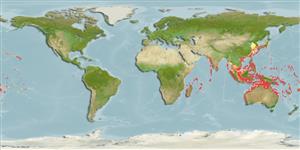Common names from other countries
Environment: milieu / climate zone / depth range / distribution range
экология
морской; солоноватоводный ассоциированный с рифами; пределы глубины 1 - 75 m (Ref. 9710). Tropical; 43°N - 32°S, 31°E - 168°W
Indo-Pacific: East Africa eastward through northern Australia extending to Samoa; north to southern Japan.
Size / Вес / Возраст
Maturity: Lm ? range ? - ? cm
Max length : 50.0 cm TL самец/пол неопределен; (Ref. 2334)
колючие лучи спинного плавника (общее число) : 3; членистые (мягкие) лучи спинного плавника (общее число) : 25 - 27; колючие лучи анального плавника: 0; членистые (мягкие) лучи анального плавника: 21 - 27; позвонки: 18. Unique color pattern of large white spots on belly, black spots on yellow background on the back, yellow snout. A white or yellowish band across snout in front of eye. Lips and the area around mouth orange-yellow. A broad vertical white, slightly yellowish band on caudal fin. Scales enlarged above pectoral-fin base and just behind gill opening to form a flexible tympanum. Rows of small anteriorly projecting spines on caudal peduncle. A prominent groove extending anteriorly from front of eye for a distance of about 1 eye diameter. Mouth terminal. Caudal peduncle compressed (Ref 9770). 39-50 rows of plate-like scales.
Lives in clear coastal to outer reef habitats (Ref. 48637). Occurs in clear seaward reefs adjacent to steep drop-offs. A solitary species (Ref. 9710). Uncommon to rare throughout most of its range (Ref. 9770). Adults usually seen along deep drop-offs, swimming about openly and may retreat to caves when approached. Juveniles secretive in small caves with rich invertebrate growth (Ref. 48637). Diet consists of sea urchins, crabs and other crustaceans, mollusks, and tunicates (Ref. 9770). Marketed fresh (Ref. 9770). Among the most highly prized aquarium fishes (Ref. 1602).
Life cycle and mating behavior
Maturities | размножение | Spawnings | Egg(s) | Fecundities | личинки
Distinct pairing (Ref. 205). Spawning occurs in patches of mixed coral rubble and sand on clear seaward reefs (Ref. 37816).
Matsuura, K., 2001. Balistidae. Triggerfishes. p. 3911-3928. In K.E. Carpenter and V. Niem (eds.) FAO species identification guide for fishery purposes. The living marine resources of the Western Central Pacific. Vol. 6. Bony fishes part 4 (Labridae to Latimeriidae), estuarine crocodiles. FAO, Rome. (Ref. 9770)
Статус Красного Списка МСОП (Ref. 130435)
CITES (Ref. 128078)
Not Evaluated
Угроза для людей
Reports of ciguatera poisoning (Ref. 4690)
Использование человеком
рыболовство: не имеет хозяйственного значения; аквариум: коммерческий
дополнительная информация
инструменты
Специальные отчеты
Скачать в формате XML
ресурсы в Интернет
Estimates based on models
Preferred temperature (Ref.
115969): 23.3 - 28.8, mean 27.3 (based on 552 cells).
Phylogenetic diversity index (Ref.
82804): PD
50 = 0.7500 [Uniqueness, from 0.5 = low to 2.0 = high].
Bayesian length-weight: a=0.02570 (0.01232 - 0.05364), b=2.94 (2.77 - 3.11), in cm Total Length, based on LWR estimates for this (Sub)family-body shape (Ref.
93245).
Trophic level (Ref.
69278): 3.3 ±0.39 se; based on food items.
устойчивость к внешним воздействиям (Ref.
120179): средний (среднего размера), минимальное время удвоения популяции 1.4-4.4 года (Preliminary K or Fecundity.).
Fishing Vulnerability (Ref.
59153): Moderate vulnerability (40 of 100).
